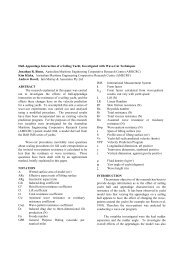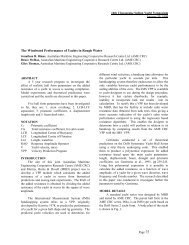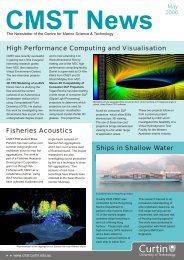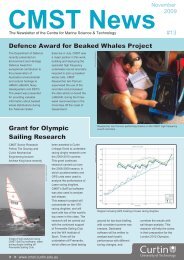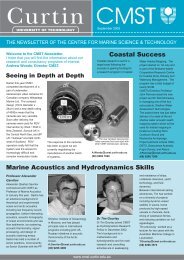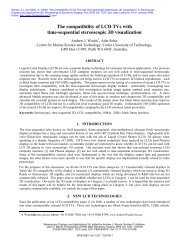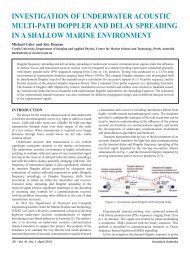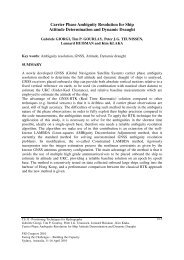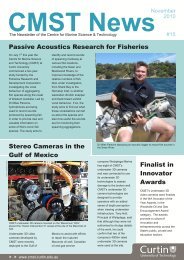Blue whale calling in the Rottnest trench-2000, Western ... - ANP
Blue whale calling in the Rottnest trench-2000, Western ... - ANP
Blue whale calling in the Rottnest trench-2000, Western ... - ANP
You also want an ePaper? Increase the reach of your titles
YUMPU automatically turns print PDFs into web optimized ePapers that Google loves.
3) Results<br />
3.1) '<strong>Blue</strong>' <strong>whale</strong> calls<br />
3.1.1) Call / Component structure<br />
The most common low frequency signals observed with typical 'blue' <strong>whale</strong> characteristics<br />
(based on literature comparisons of blue <strong>whale</strong> spectrograms), was a sequence of three long tonal<br />
signals with most energy <strong>in</strong> <strong>the</strong> band 16-100 Hz. These three 'components' always occurred <strong>in</strong> a<br />
set sequence. The nomenclature used <strong>in</strong> this document is that toge<strong>the</strong>r <strong>the</strong> three components<br />
made a s<strong>in</strong>gle call. Calls were repeated <strong>in</strong> a stereotyped pattern at a consistent <strong>in</strong>terval between<br />
<strong>the</strong> end of one and <strong>the</strong> start of <strong>the</strong> next, with <strong>the</strong> <strong>in</strong>terval at 70-85 s (mean at 78 ± 8 s, 95%<br />
confidence limits). An example of five call sequences repeated over 15 m<strong>in</strong>utes is shown on<br />
Figure 6. Although <strong>the</strong>se calls display 'typical' characteristics of previously reported blue <strong>whale</strong><br />
calls, <strong>in</strong> <strong>the</strong> presence of very long (> 10 s), <strong>in</strong>tense, narrow band tones with most energy <strong>in</strong> <strong>the</strong><br />
range 10-30 Hz (ie. Cumm<strong>in</strong>gs and Thompson 1971; Cumm<strong>in</strong>gs et al 1971; McDonald et al<br />
1995; Stafford et al 1999), <strong>the</strong>re are no published calls which match well with those reported<br />
here. This reflects <strong>the</strong> difficulty <strong>in</strong>volved <strong>in</strong> correlat<strong>in</strong>g calls with sources <strong>in</strong> <strong>the</strong> mar<strong>in</strong>e<br />
environment comb<strong>in</strong>ed with <strong>the</strong> low effort and difficult logistics of describ<strong>in</strong>g <strong>the</strong> calls of<br />
sou<strong>the</strong>rn hemisphere oceanic baleen <strong>whale</strong>s. Given <strong>the</strong> strong parallels with o<strong>the</strong>r blue <strong>whale</strong><br />
calls, <strong>the</strong>n at <strong>the</strong> m<strong>in</strong>imum <strong>the</strong> calls described here are attributable to blue <strong>whale</strong>s. It is believed<br />
from <strong>the</strong> boat based studies run concurrently, that <strong>the</strong> blue <strong>whale</strong>s observed <strong>in</strong> <strong>the</strong> <strong>Rottnest</strong><br />
<strong>trench</strong> over <strong>the</strong> study period were pr<strong>in</strong>cipally pygmy blue <strong>whale</strong>s. Biopsy samples of seven<br />
<strong>whale</strong>s were taken <strong>in</strong> <strong>2000</strong> and genetic analysis of <strong>the</strong>se samples should determ<strong>in</strong>e if <strong>the</strong> <strong>whale</strong>s<br />
sighted were true blue or pygmy blue <strong>whale</strong>s. For <strong>the</strong> duration of this document <strong>the</strong>y are simply<br />
referred to as blue <strong>whale</strong>s.<br />
Figure 6: Example of five sequences of <strong>the</strong> three component blue <strong>whale</strong> calls, over a 15 m<strong>in</strong>ute period. The<br />
horizontal bands were tones from a nearby small boat. The blue <strong>whale</strong> <strong>call<strong>in</strong>g</strong> had most energy between 18-26 Hz<br />
but also displays harmonics and a secondary call source up to frequencies of 100 Hz.<br />
10



